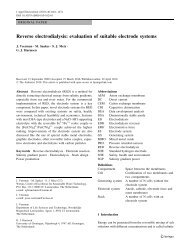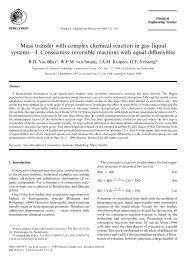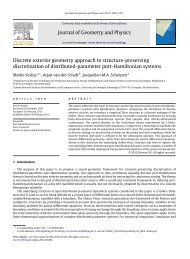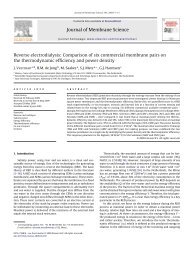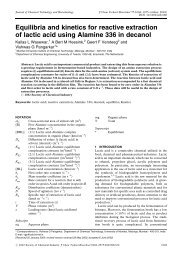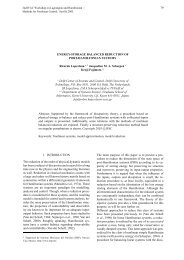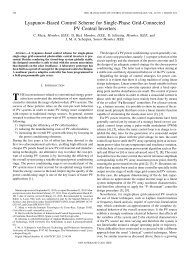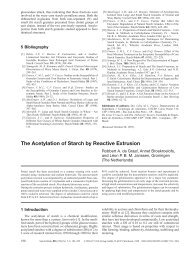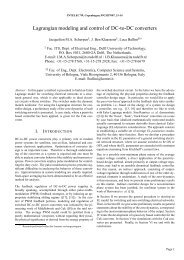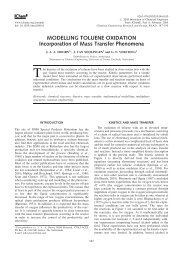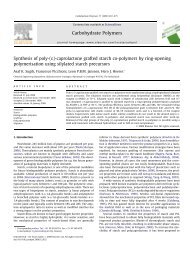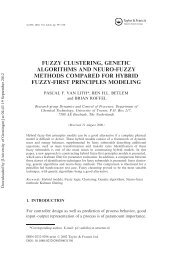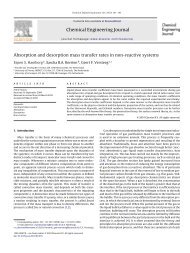Mass transfer with complex chemical reaction in gas—liquid ... - ITM
Mass transfer with complex chemical reaction in gas—liquid ... - ITM
Mass transfer with complex chemical reaction in gas—liquid ... - ITM
- No tags were found...
You also want an ePaper? Increase the reach of your titles
YUMPU automatically turns print PDFs into web optimized ePapers that Google loves.
R.D. Vas Bhat et al./Chemical Eng<strong>in</strong>eer<strong>in</strong>g Science 54 (1999) 137—147 147curve before approach<strong>in</strong>g the f<strong>in</strong>al <strong>in</strong>f<strong>in</strong>ite enhancementfactor.F<strong>in</strong>ally, the model presented <strong>in</strong> this paper has beenused to determ<strong>in</strong>e differential selectivity towards the <strong>in</strong>termediate<strong>in</strong> the consecutive <strong>reaction</strong> scheme. Experimentaldata presented previously by Pangarkar andSharma (1974) for the chlor<strong>in</strong>ation of p-cresol have beenused for this purpose. As has been reported earlier,a strong <strong>in</strong>fluence of mass <strong>transfer</strong> parameters on theselectivity of the <strong>in</strong>termediate was observed <strong>with</strong> selectivityreduc<strong>in</strong>g <strong>with</strong> an <strong>in</strong>crease <strong>in</strong> Hatta number. In practice,however, a compromise needs to be reached betweenselectivity towards the <strong>in</strong>termediate on the one hand andconversion on the other. Due to lack of comprehensivedata such as equilibrium constants, the full potential ofthe model could not be exploited.The present model provides a rigorous mathematicalanalysis of the consecutive <strong>reaction</strong> system under conditionsof unequal diffusivity. With a view of encourag<strong>in</strong>gfurther numerical and/or approximate exam<strong>in</strong>ation ofthis <strong>reaction</strong> scheme, a selection of results (obta<strong>in</strong>ed <strong>with</strong>this model) has been presented <strong>in</strong> Table 4.AcknowledgementsThe authors wish to thank Akzo Nobel Central Research(the Netherlands) for their f<strong>in</strong>ancial support tothis <strong>in</strong>vestigation and A.P. Higler for his assistance <strong>in</strong> thenumerical solution of the model.NotationA component A, concentration of componentA, mol mA total A <strong>in</strong> all forms ("A #D #E ), dimensionless B component B, concentration of component B,mol mB total B <strong>in</strong> all forms ("B #D ), dimensionless C component C, concentration of componentC, mol mD component D, concentration of componentD, mol mD diffusivity, sub: component, m sE component E, concentration of component E,mol mE enhancement factor, def<strong>in</strong>ed by <strong>reaction</strong> (2b),dimensionlessE f<strong>in</strong>al <strong>in</strong>f<strong>in</strong>ite enhancement factor, dimensionlessE <strong>in</strong>termediate asymptotic enhancement factor,dimensionlessHa Hatta number, def<strong>in</strong>ed by <strong>reaction</strong> (2c), dimensionlessK K k k N r equilibrium constant, sub: <strong>reaction</strong> number,dimensionlessk /k , dimensionless <strong>reaction</strong> rate constantsub1: <strong>reaction</strong> number, sub2: <strong>reaction</strong> direction,m mol sliquid-side mass <strong>transfer</strong> coefficient, m sgas flux, mol m sdiffusivity ratio, def<strong>in</strong>ed by D /D , sub: component, dimensionlessGreek lettersα load<strong>in</strong>g factor ("A /B ), dimensionless σ differential selectivity, def<strong>in</strong>ed by Eq. (5a), dimensionlessζ conversion of p-cresol, def<strong>in</strong>ed by Eq. (5b),dimensionlessSubscripts0 <strong>in</strong>itial conditionG, g gas phasei <strong>in</strong>terface¸, l liquid phasered reduced¹ totalAbbreviationsMCPC monochloro-p-cresolDCPC dichloro-p-cresolReferencesDarde, T., Midoux, N., & Charpentier, J.C. (1983). Contribution to theanalysis of the selectivity <strong>in</strong> <strong>gas—liquid</strong> <strong>reaction</strong> part I: literature andtheory. Chem. Engng Commun., 22, 221—241.Darde, T., Midoux, N., & Charpentier, J.C. (1984). Contribution to theanalysis of the selectivity of <strong>gas—liquid</strong> <strong>reaction</strong>s part II: comparisonof experimental results <strong>with</strong> model predictions. Chem. Engng Commun.,26, 33—54.DeCoursey, W.J., & Thr<strong>in</strong>g, R.W. (1989). Effects of unequal diffusivitieson enhancement factors for reversible and irreversible <strong>reaction</strong>.Chem. Engng Sci., 44, 1715—1721.Hashimoto, K., Teramoto, M., Nagayasu, T., & Nagata, S. (1968). Theeffects of mass <strong>transfer</strong> on the selectivity of <strong>gas—liquid</strong> <strong>reaction</strong>s. J.Chem. Engng (Japan), 1, 132—138.Pangarkar, V.G., & Sharma, M.M. (1974). Consecutive <strong>reaction</strong>s: roleof mass <strong>transfer</strong> factors. Chem. Engng Sci., 29, 561—569.Teramoto, M., Fujita, S., Kataoka, M., Hashimoto, K., & Nagata, S.(1970). Effect of bubble size on the selectivity of consecutive<strong>gas—liquid</strong> <strong>reaction</strong>s. J. Chem. Engng (Japan), 3, 79—82.Vas Bhat, R.D., van Swaaij, W.P.M., Kuipers, J.A.M., & Versteeg, G.F.,<strong>Mass</strong> <strong>transfer</strong> <strong>with</strong> <strong>complex</strong> <strong>chemical</strong> <strong>reaction</strong> <strong>in</strong> <strong>gas—liquid</strong> systems—partI: consecutive reversible <strong>reaction</strong>s <strong>with</strong> equal diffusivities.Chem. Engng Sci., 54, 121—136.Vusse, J.G. van de (1966a). Consecutive <strong>reaction</strong>s <strong>in</strong> heterogeneoussystems I—the effect of mass <strong>transfer</strong> on selectivity. Chem. EngngSci., 21, 631—643.Vusse, J.G. van de (1966b). Consecutive <strong>reaction</strong>s <strong>in</strong> heterogeneoussystems II—<strong>in</strong>fluence of order of <strong>reaction</strong> rates on selectivity. Chem.Engng Sci., 21, 645—654.



